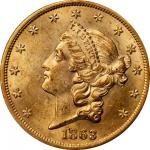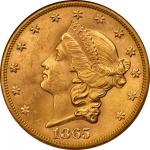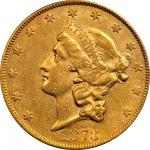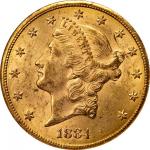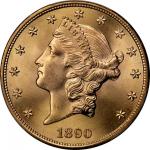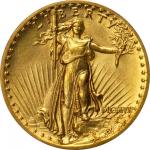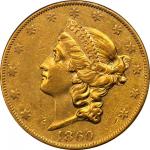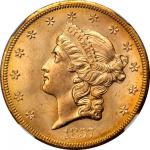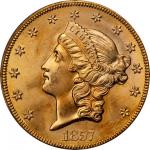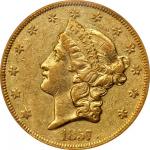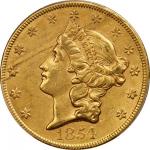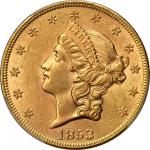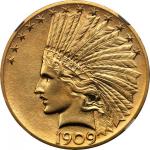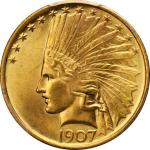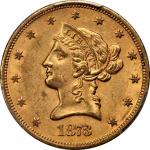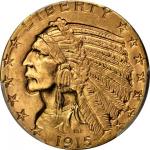The 1861-O is arguably the most historic and appealing issue in the entire New Orleans Mint double eagle series of 1850 to 1879 and also among the most intriguing. The story of the 1861-O double eagle begins ordinarily enough with the Philadelphia Mint s shipment of three pairs of dies to New Orleans on December 30, 1860. Q. David Bowers ( A Guide Book of Double Eagle Gold Coins, 2004 ) presumes that the three reverse dies were of the brief and ultimately unsuccessful Paquet design and were not used. Most numismatic scholars agree that the New Orleans Mint used only a single set of dies for this issue, one of the obverse dies it received from the Philadelphia Mint and a leftover reverse of the standard Type I Liberty design received in an earlier year. Using these dies coinage commenced at the start of the year and by January 26, 1861, the facility had struck 5,000 coins on behalf of the federal government.On that date Louisiana announced its secession from the Union, joining several other Southern states in response to Abraham Lincoln s election as president. Double eagle production continued at the New Orleans Mint, but the 9,750 pieces delivered between January 26 and March 31 were produced under authority of the State of Louisiana. On February 8, 1861, in Montgomery, Alabama, representatives from South Carolina, Mississippi, Florida, Alabama, Georgia and Louisiana created the Confederate States of America. By March 21 Louisiana s Secession Convention had accepted the Confederate Constitution, and on April 1 control of the New Orleans Mint formally passed to the Confederacy, with the same personnel that had previously served both the federal government and the State of Louisiana remaining in place. Double eagle production resumed in early April, with an additional 2,991 pieces struck before a lack of bullion resulted in no more coins being struck after April 30. In total, the New Orleans Mint struck 17,741 double eagles throughout the first four months of 1861. Produced under the authority of three governments during one of the most historically significant and interesting periods in U.S. history, the 1861-O double eagle appeals not only to numismatists, but also to Civil War history buffs. Researchers have long sought to determine exactly which 1861-O double eagles were struck under authority of the Confederate States during April of that year, but so far no conclusive evidence has been brought forth. The closest we have is the theory provided by Douglas Winter in the 2006 edition of the book Gold Coins of the New Orleans Mint: 1839-1909. Winter s theory is based on the various die states of the single obverse die used to strike this issue. The vast majority of surviving examples (75% according to Winter) exhibit a weak date with the bottoms of the digits 186 extremely faint, if not absent, due to the date logotype being lightly punched into the die. This work was done in the Philadelphia Mint, where all dies for U.S. coinage were produced at that time. A far smaller number of 1861-O double eagles exhibit crude strengthening to the base of the digit 8 in the form of three engraving lines. This work was obviously done by hand in the New Orleans Mint, which lacked the equipment (specifically numeral punches) to do the job properly. As these "strengthened date" coins also exhibit a die crack at star 2 on the obverse, the depth of which is such as to preclude effacing through die lapping, Winter conjectures that these pieces were struck after their weak date counterparts and, thus, can be attributed to the Confederate States of America. The facts that the CSA mintage is significantly less than that of the Union and State of Louisiana mintages combined, and that the "strengthened date" pieces are rarer than their weak date counterparts to nearly the same extent, also support Winter s theory. Yet a theory it remains. The historic significance of the 1861-O double eagle is well established and, regardless of striking authority, all surviving examples are a numismatic link to the foundation of the Confederacy and the start of the Civil War. Indeed, all examples were struck from the last set of dies used by the New Orleans Mint under federal authority, and the same set of dies that the facility used to strike double eagles to help fund the Confederacy in its struggle for independence from the United States. This is a lovely example with superior technical quality and above average eye appeal for the grade. Vibrant medium gold surfaces reveal flickers of an original semi-prooflike finish in the protected areas around the devices. This finish is characteristic of the issue, although very few survivors retain even the modest traces of it seen here. Definition is bold except for the bottoms of the digits 186 in the date, which are soft, as discussed above. There is no die crack at star 2. This is one of the nicest 1861-O double eagles in any grade that we have ever handled, and is sure to command the attention of advanced double eagle specialists and Civil War collectors alike. The 1861-O is the final Type I Liberty double eagle issue from the New Orleans Mint, and the last produced prior to 1879, by which time the Type III design had been adopted. It is an elusive issue in numismatic circles with fewer than 175 coins believed extant in all grades, most of which grade VF or EF. The 1861-O is the seventh rarest of the 13 O-Mint double eagle issues, and it is more challenging to obtain than the 1850-O, 1851-O, 1852-O, 1853-O, 1857-O and 1858-O. , Est. $40,000-$60,000

